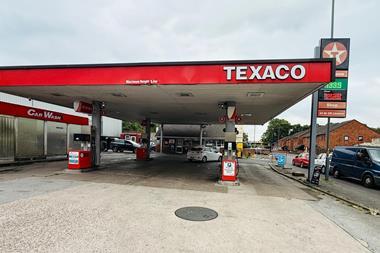With ever-tighter fuel margins never has there been a more critical time to know the status of your fuel stocks. You need to be able to track every drop, so you can see how much is vapour loss, how much could be leaking, and how much might be down to being short-changed on fuel deliveries. Those reading last month’s issue of Forecourt Trader will have seen that the PRA has launched a fighting fund to tackle the integrity of measurement for motor fuel deliveries.
Because there’s no measurement at the delivery point, wetstock management is vital in providing evidence of under-delivery to the oil company. Billy Tank, sales director of Torex Retail UK (formerly Arciris) says: “We can’t ignore the issues retailers have with hot product and the reported problems with short supply of diesel resulting in deliveries within hours of being produced. The historical perception of cool delivery may no longer be the case due to these short delivery timescales, which could give retailers a shrinkage issue.”
Tank says there are many ways of capturing the necessary information to detect losses, such as the Iridium epos system, which is installed in more than 1,300 locations throughout the UK. Delivery information is typed into the pos by the cashier, and this data, along with accurate sales data, is polled back to the analysts at Torex for detailed examination. “While most retailers make every effort to ensure their wetstock figures are correct, history tells us that a £4m turnover site loses some 16,000 litres of fuel per annum – 0.4 of one per cent,” confirms Tank.
But while the current topic of conversation throughout the industry is ‘hot product’, this is estimated to represent only some 40 per cent of the losses incurred – the remaining 60 per cent is through line leaks and over metering at the nozzle, according to Tank: “A giveaway of 100ml per 20 litres delivered is not an unusual occurrence,” he says. “Our customer base shows consistent savings of 50 per cent of these giveaway losses through timely intervention.”
Last year Arciris and Mercury Petroleum Systems joined forces when they both became part of Torex Retail last year, and as a result, the company now offers retailers a one-stop solution. “By joining forces this gives the Iridium and Prism back-office user more focus on wetstock and trend analysis, as we are able to remove the information from site daily without the customer having to do back office reconciliation,” says Tank. “We can confirm most back office systems do not always do a daily reconciliation which holds up a vital few days when we are looking for over-issue at the pump and any form of leak from the system. We take monitoring as one problem, then standard temperature accounting as a separate issue, and can report on both if the systems are integrated.”
Brian Reed, business development manager at Fairbanks Environmental, agrees that reconciliation of the data is one of the most important aspects of fuel management. “On its own a daily wetstock variance figure does not give the site operator an awful lot of information,” he says. “The simple process of extending the reconciliation period from one day to one month allows site operators to begin to notice trends. One month’s figures may be higher than the previous month’s, or this year’s figure may be different from the same time last year. This is trend analysis at its most basic form.”
Reed adds that the retailer’s greatest strength comes in the use of Statistical Inventory Reconciliation (SIR) to analyse the trends within wetstock reconciliation data, not just for the tanks on an individual site, but by grouping several hundred tanks which have the same characteristics – such as supply source, throughput, and geographical location.
“The point at which you might be excused for thinking you had completed your wetstock reconciliation, be it on a piece of paper, a spreadsheet, a backoffice PC package or a reconciling tank gauge, is the point where Fairbanks will start the analysis,” says Reed. By feeding your data into their system Fairbanks will compare your losses with an established profile for each tank on your site.
“Unfortunately there is no miracle cure for wetstock loss – not even Standard Temperature Accounting – but Fairbanks’ twofold message is straightforward,” explains Reed. “Firstly there are certain causes of wetstock loss that you can do something about and certain causes that are beyond your control. Deal with the things that you can influence – this will get you to a position where at least you know that your losses are no higher than they could be.
“The second point is that once Fairbanks has established the normal profile for each of your tanks any deviation from that norm will quickly be identified and we will work with you to investigate and put right the causes of the extra losses. This will give you the reassurance that should the worst happen and you experience a tank or line leak, it will not go undetected for a long period leaving you with a remediation bill that could spell the end of your business.”
FLEXIBLE APPROACH
Gilbarco Veeder-Root’s Fuel Management Service has a modular structure designed to give retailers the flexibility to match service levels to the requirements of the individual business. The wetstock management module offers risk management through regular certified leak detection, automated reconciliation and loss reports, and loss identification. Variance Management can be included for enhanced loss breakdown and leak detection for high-risk sites, and through Alarm Monitoring retailers can receive real-time environmental alarms and automatic third-party notification of critical tank events.
Because losses attributable to over-dispensing meters, delivery shortfalls, temperature variation and fraud can be considerable Gilbarco Veeder-Root’s FMS also offers two levels of loss analysis. Other available modules within the Gilbarco Veeder-Root FMS include Inventory Planning, which helps retailers plan deliveries and collect real-time site inventory data on demand; and Delivery Scheduling, which optimises deliveries based on fuel usage, gives predicted run-out date and time, and optimal inventory at the site.
TANK GAUGING
Tank gauging is another important aspect of wetstock management. Since April last year, Dresser Wayne has been selling tank gauge equipment manufactured by OPW. Alistair Clarke, sales & marketing director at Dresser Wayne, says: “The TIG 5000 gauge has proved to be a successful addition to our product range, with a major supermarket and dealer operators included in the growing customer list. We are seeing a lot of interest in the remote management of gauges and have established a customer support unit to provide dial-in maintenance and configuration services.”
The TIG 5000 is available in numerous tank and leak sensor configurations and provides precision inventory reconciliation with the optional Reconciliation Interface Module. Data from tanks, deliveries and metered sales are collected to produce Precision Inventory Reconciliation Reports that enhance site management capabilities.
Dresser Wayne also supplies the TIG 1000 tank inventory gauge system, which provides inventory, delivery, and environmental compliance for up to 16 underground storage tanks.
VAPOUR RETENTION
One of the best ways to reduce stock losses is by reducing the generation of vapour recovered back to the road tanker. Petroman has developed two complementary systems to do just that – Soft Fill and Accumulus are both designed to help retailers save money by reducing stock losses.
Because fuel deliveries allow the fuel to wash up and down the tank releasing vapour within the tank, Petroman’s Soft Fill vapour management
stem is designed to reduce the effect and retain as much vapour in the retailers’ tank. As the fuel delivery starts, air in the delivery pipe is forced into the tank causing turbulence and vapour. The fuel then hits the bottom of the tank and causes more waves that generate further vapour, which is returned back to the road tanker. With Soft Fill the fuel is delivered down the existing pipe and then dispersed through a series of smooth apertures, allowing the free flow of the fuel into the tank. The effect is a calmer delivery resulting in less vapour generation.
Each tank is fitted with Petroman’s patented Soft Fill beam, which is connected onto the bottom of the fill pipe and rests on the floor of the tank using a hinged system. Investment starts from £2,450 per tank and Keith Norman, managing director of Petroman, says that retailers can expect payback within about 18 months, depending on the number of deliveries the site receives each week.
There is also a separate Soft Fill system for diesel tanks. “This is nothing to do with vapour but has everything to do with stock loss through hot product,” explains Norman. “If a retailer is getting hot diesel delivered – and we’ve experienced diesel as hot as 30 degrees C – Soft Fill controls the way hot diesel is delivered into the tank.”
Petroman’s Accumulus vapour recovery system will also help to reduce the amount of vapour recovered into the tanker. The vapour management and retention system is retrofitted into the fill-pipe of the site storage tank, giving total vapour containment. The highly reactive component is located directly in the fuel delivery system and is installed as an integral component of the fill pipe, through which the fuel is delivered. The venturi (part of the Accumulus valve) only operates when the fuel is being delivered. As the delivery takes place the venturi creates a vacuum, which pulls vapour back into the liquid flow.
According to Norman, the overall effect of this is to blend the vapour back into the liquid flow, reducing the volume of vapour in the tank therefore reducing the vapour pressure. “Once installed there are virtually no operating costs other than maintenance and routine inspections,” he says. “Tests have proven this system to be highly effective at reducing wet stock losses. Accumulus can give lower maintenance costs, reduced aborted deliveries, reduced emergency call outs, three-year guarantee, and reduced component wear.”
Accumulus is only suitable for sites with large tanks to retain the vapour and costs from £3,200 per tank. Again, payback depends on how many deliveries the site receives each week. “For sites with less than two tankers a week, payback would be too long,” says Norman. “We would say that minimum volume is three million litres of spirit per year.”
Risbridger has also developed a system to help minimise vapour loss. The system takes a dual approach – minimising vapour creation with the RIS-Diffuser and RIS-ATV (air transfer valve), and minimising air exchange with the RIS-Retainer.
“In practice during a site delivery, Stage 1B generally sucks all the vapour away into the tanker replacing the vapour with clean air drawn from the pressure vacuum valve,” explains a spokesperson for Risbridger. “Over time this clean air in contact with the fuel forms new fuel vapour. This causes vapour loss that could have been avoided if a portion of the displaced vapour was retained in the tank under light pressure. This is the purpose of the RIS-Retainer that combines the function of a vapour recovery adaptor and tank farm pressure control.”
Risbridger says that between 0.2 and 0.4 per cent of fuel delivered to forecourts is lost through vaporisation. “We estimate that approximately half of this loss can be avoided by using a combination of RIS-Diffuser, RIS-ATV, and RIS-Retainer, as well as through general care with site vapour leakage points including fill caps, overfill valves, drop tubes and vents.”


























No comments yet